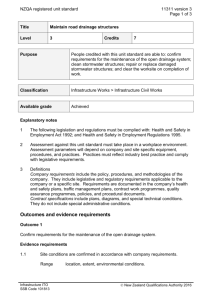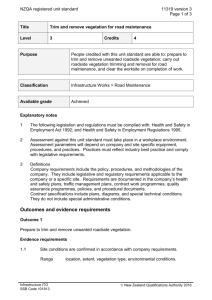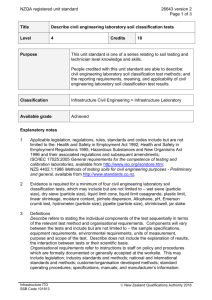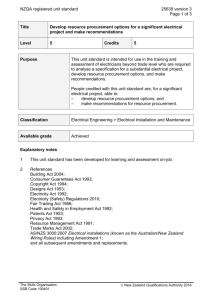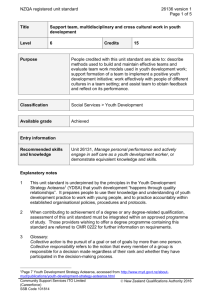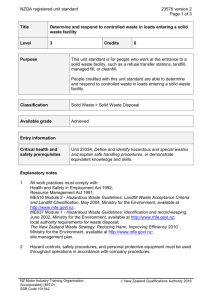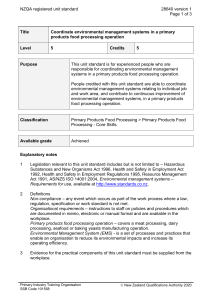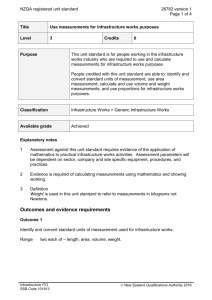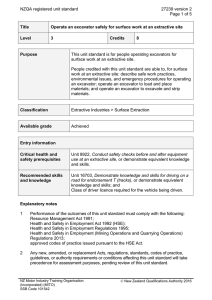17310 Operate a hydraulic excavator on infrastructure works
advertisement
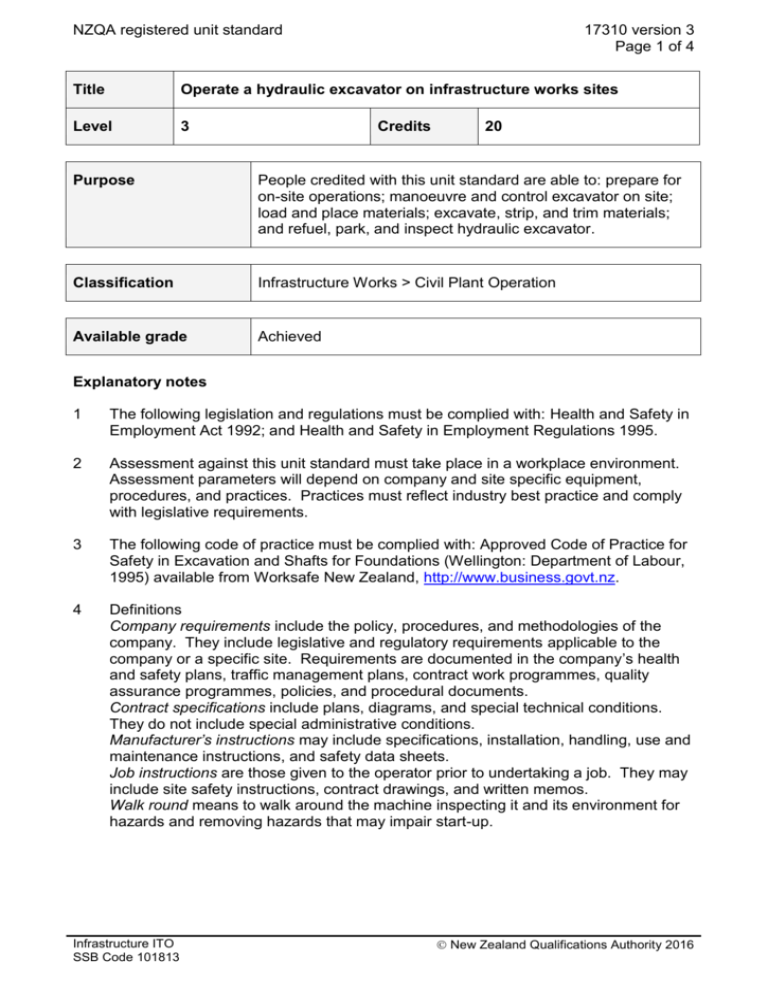
NZQA registered unit standard 17310 version 3 Page 1 of 4 Title Operate a hydraulic excavator on infrastructure works sites Level 3 Credits 20 Purpose People credited with this unit standard are able to: prepare for on-site operations; manoeuvre and control excavator on site; load and place materials; excavate, strip, and trim materials; and refuel, park, and inspect hydraulic excavator. Classification Infrastructure Works > Civil Plant Operation Available grade Achieved Explanatory notes 1 The following legislation and regulations must be complied with: Health and Safety in Employment Act 1992; and Health and Safety in Employment Regulations 1995. 2 Assessment against this unit standard must take place in a workplace environment. Assessment parameters will depend on company and site specific equipment, procedures, and practices. Practices must reflect industry best practice and comply with legislative requirements. 3 The following code of practice must be complied with: Approved Code of Practice for Safety in Excavation and Shafts for Foundations (Wellington: Department of Labour, 1995) available from Worksafe New Zealand, http://www.business.govt.nz. 4 Definitions Company requirements include the policy, procedures, and methodologies of the company. They include legislative and regulatory requirements applicable to the company or a specific site. Requirements are documented in the company’s health and safety plans, traffic management plans, contract work programmes, quality assurance programmes, policies, and procedural documents. Contract specifications include plans, diagrams, and special technical conditions. They do not include special administrative conditions. Manufacturer’s instructions may include specifications, installation, handling, use and maintenance instructions, and safety data sheets. Job instructions are those given to the operator prior to undertaking a job. They may include site safety instructions, contract drawings, and written memos. Walk round means to walk around the machine inspecting it and its environment for hazards and removing hazards that may impair start-up. Infrastructure ITO SSB Code 101813 New Zealand Qualifications Authority 2016 NZQA registered unit standard 17310 version 3 Page 2 of 4 Outcomes and evidence requirements Outcome 1 Prepare for on-site operations. Evidence requirements 1.1 Job instructions are confirmed in accordance with company requirements 1.2 Walk round is completed prior to starting work in accordance with company requirements. 1.3 Machine operation is checked prior to starting work in accordance with manufacturer’s instructions. Range visibility, seat belt, engine controls and gauges, throttle position, hydraulic controls; check controls and gauges after warm-up. Outcome 2 Manoeuvre and control excavator on site. Evidence requirements 2.1 Excavator is manoeuvred on site with adequate clearances in accordance with job instructions. Range slew and working clearances include but are not limited to – overhead wires, underground services, proximity of people and plant, trenching works, working a face, handling loads. 2.2 Machine control levers are used to produce smooth movement of bucket through all positions. 2.3 Excavator is controlled on slopes in accordance with company requirements. 2.4 Machine production is maintained at maximum usage relative to the task and the safety of the operator. Range 2.5 Sequence and work methods are chosen to ensure safety of people and plant. Range 2.6 placement of vehicle being loaded. may include – road traffic. Sequence and work methods are selected in accordance with achieving job requirements in allotted time. Infrastructure ITO SSB Code 101813 New Zealand Qualifications Authority 2016 NZQA registered unit standard 2.7 17310 version 3 Page 3 of 4 When manoeuvring excavator, items in the vicinity are preserved at all times. Range may include – survey pegs and settings, road furniture, roadside amenities, structures, adjacent property, and protected trees. Outcome 3 Load and place materials. Evidence requirements 3.1 Communication is maintained with load vehicle driver at all times during loading operations. Range giving directions for the positioning of load vehicles. 3.2 Excavator is positioned strategically and material is placed in load vehicle in accordance with company requirements. 3.3 Materials are placed with minimal spillage in accordance with job instructions. Outcome 4 Excavate, strip, and trim materials. Evidence requirements 4.1 Topsoil is stripped to contour and depth in accordance with job instructions. 4.2 Area for specified job is excavated to the depth and level in accordance with job instructions. 4.3 Materials are carried in safe load position and with operator showing awareness of the operating environment at all times. Range includes but is not limited to – reversing, working on slope. Outcome 5 Refuel, park, and inspect hydraulic excavator. Evidence requirements 5.1 Hydraulic excavator is refuelled and oil checked in accordance with company requirements. 5.2 Hydraulic excavator is parked, shut down safely, and secured in accordance with company requirements. 5.3 Hydraulic excavator is inspected and any faults are reported in accordance with company requirements. Infrastructure ITO SSB Code 101813 New Zealand Qualifications Authority 2016 NZQA registered unit standard Planned review date 17310 version 3 Page 4 of 4 31 December 2019 Status information and last date for assessment for superseded versions Process Version Date Last Date for Assessment Registration 1 30 May 2000 31 December 2014 Review 2 25 September 2006 31 December 2016 Review 3 19 February 2015 N/A Consent and Moderation Requirements (CMR) reference 0101 This CMR can be accessed at http://www.nzqa.govt.nz/framework/search/index.do. Please note Providers must be granted consent to assess against standards (accredited) by NZQA, before they can report credits from assessment against unit standards or deliver courses of study leading to that assessment. Industry Training Organisations must be granted consent to assess against standards by NZQA before they can register credits from assessment against unit standards. Providers and Industry Training Organisations, which have been granted consent and which are assessing against unit standards must engage with the moderation system that applies to those standards. Requirements for consent to assess and an outline of the moderation system that applies to this standard are outlined in the Consent and Moderation Requirements (CMR). The CMR also includes useful information about special requirements for organisations wishing to develop education and training programmes, such as minimum qualifications for tutors and assessors, and special resource requirements. Comments on this unit standard Please contact the Infrastructure ITO qualifications@infrastructureito.org.nz if you wish to suggest changes to the content of this unit standard. Infrastructure ITO SSB Code 101813 New Zealand Qualifications Authority 2016

